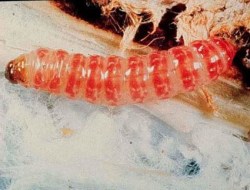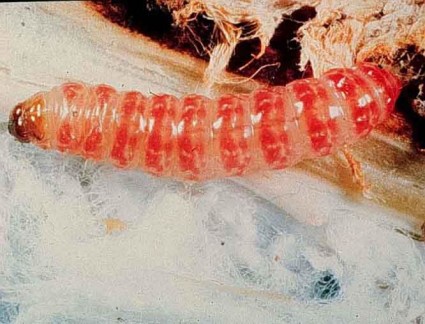
North Carolina State UniversityThe pink bollworm: the bug that ate Monsanto’s Bt franchise?
The current crop of superweeds plaguing farmers who rely on Monsanto’s RoundUp pesticide represents by now a well documented crisis. But watch out, world! Here come the superbugs.
That’s right, Monsanto’s other flagship product, its “Bt” line of genetically modified seeds which emit their own pesticide in the form of a naturally occurring toxin, is now under threat from resistant insects. Science Magazine ($ub req’d) has the details:
Monsanto has revealed that a common insect pest has developed resistance to its flagship genetically modified (GM) product in India. The agricultural biotechnology leader says it “detected unusual survival” of pink bollworms that fed on cotton containing the Cry1Ac gene from the bacterium Bacillus thuringiensis (Bt), which codes for a protein that’s toxic to many insect pests. In a statement to Science, Monsanto claims that the finding from western India “is the first case of field-relevant resistance to Cry1Ac products, anywhere in the world.”
This development comes despite Monsanto’s long history of downplaying the probability of the evolution of Bt resistant insects. In some ways, this is a worst case scenario for the biotech giant with both its main genertically engineered seed traits now under attack by Mother Nature. As a result, some analysts marveled at Monsanto’s casual announcement of a development that could lead to a collapse of one of its main money-makers:
One prominent researcher questions whether the Gujarat bollworms truly are resistant. Monsanto’s conclusions and methodology are “flawed,” charges CICR Director Keshav Raj Kranthi, an entomologist. In 8 years of monitoring Bt cotton, he says, CICR has “not found any resistance.” Kranthi argues that Monsanto “should have analyzed tens of thousands of specimens before making this claim. … It’s a mystery why Monsanto is trying to kill its own technology.” Monsanto disputes that charge; it says its resistance tests were “standard practice” but declined to elaborate on its methodology.
Perhaps it’s worth keeping in mind that Monsanto is in the midst of trying to move farmers from its first-generation Bt seed, to its newer [more expensive] second generation Bt seed which expresses multiple versions of the Bt toxin. In theory, this new seed would kill pests that the first gen version might not. Do I smell an ulterior motive?
It’s also true that scientists who don’t get their paychecks via Monsanto have been warning of Bt resistant insects for quite some time — and the Science article mentions the fact that, despite Monsanto’s claim, resistance to Bt has been seen in North America already. These risks are one of the reasons why the EPA requires farmers to plant “buffer zones” of non-GMO crops around any GMO field which theoretically minimizes the resistance risk. However, as the NYT reported last fall, a surprising number of US farmers ignore those guidelines and increasing the probability of resistant insects.
But it’s not just Monsanto we should be worried about — the NYT observed that widespread Bt resistance would be a huge problem for large organic growers because Bt toxin insecticides are one of the few organic options available. India, which is in the midst of an agricultural crisis and is attempting a significant increase in organic agriculture, is the last place you’d want to see something like this happen.
As one expert summed up the significance of this latest news on GMOs:
I hope that this episode will cut down on the belief … that Bt has some magical immunity to resistance.
Huh. And I thought it was GMO opponents who were the ones accused of indulging in magical thinking. Well, Monsanto, how’s that shoe feel now?



